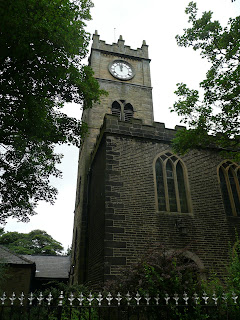 |
| Hayfield Church |
A few days on from our first family expedition along the Peak Forest Canal Manchester – Sheffield line.
 |
| Sett Valley Trail Sign |
Usage of the Sett Valley Trail may have declined in recent years as the once popular cycle hire that operated at the former Hayfield Station no longer operates. I suspect that this was because the cycle path is actually a bit short even for family cyclists, weighing in at only 2.5 miles from Hayfield to New Mills. Still for two small children aged 3 and 6 that is still a considerable distance to walk!
 |
| Sett Valley Cottages |
We started our walk at the site of Hayfield Station, where there is a visitor centre, car park and picnic area but no visible remains of a station. Old pictures of what it once looked like can be found at http://www.hayfield.uk.net/Railway.html. Soon after closure in 1970 Derbyshire County Council stepped in and purchased the site, but the station buildings became a casualty in 1975 making way for the visitor facilities now occupying the site. We started this end of the trail principally because it is easy to park here, but also I wanted to end the walk at The Torrs Country Park, an area I consider to be the highlight of the walk.
 |
| Seat With a View |
Once we left Hayfield station the former railway line is much like any other for the first mile or so with long straight sections enclosed by trees giving very little opportunity for views outwards into the surrounding countryside. However, this is very good terrain for keeping an eye on kids who want to run as fast as they can ahead. The line must have been relatively easy to build for there are few engineering features along its route apart from a short viaduct that the line still crosses to the west of Birch Vale, and a short tunnel that is blocked off just before New Mills junction. However, there are still other reminders of its railway heritage with a crossing keepers cottage at Birch Vale now turned into a very desirable house and out in the fields a redundant wagon (yes another!).
 |
| Crossing Keeper's Cottage |
The stretch between Hayfield and what was once the only intermediate station at Birch Vale (no trace remaining) is perhaps the most attractive section of the route with odd glimpses outwards of Lantern Pike and the valley of the River Sett (from which the trail takes its name). Lined up along the route are quite a few raspberry plants and there were plenty of berries ripening on the canes. We left them for the birds to eat as they still looked a bit green. We also spotted a frog hopping through the damp grass, a sight that would have been unthinkable in railway days.
 |
| Birch Vale Bridge |
At Birch Vale the bridge that crossed the road has been removed and the walker/ cyclist has to cross at level, which was a bit disconcerting. A similar situation exists just before reaching the edge of New Mills although in the second case the road was a lot quieter. After a relatively pleasant but unexciting mile or so of railway walking from Birch Vale, the edge of New Mills brings a change of pace for the Sett Valley Trail. This is largely the result of the trail now having to fit in with the development around it squeezing in from all sides. It had been some years since I have walked this stretch and was rather surprised at how it had changed. Much of the original trackbed has been lost, replaced instead by a walk that continues along the same corridor but with the profile of the track changed to suit the needs of walkers/ cyclists rather than trains! Overbridges have been sacrificed and filled in and earthworks have been modified to make way for developments that have encroached onto the former trackbed. The upshot of all this development is that reinstating the line is probably now virtually impossible from a practical point of view even though its route corridor has been protected.
 |
| The Torrs |
Just past a doctors surgery that has been built across the trackbed in New Mills, the railway line enters its final throes before disappearing into the short tunnel that led into New Mills Central station. The tunnel is closed off now but for the walker there is adequate compensation in the shape of The Torrs Country Park. This strange, almost subterranean world sits for below the town of New Mills Country Park
 |
| Millennium Walkway |
After exploring the remains of the mills we also took a look at the Millennium Walkway, a spectacular bridge built in 2000 to enable walkers to follow a previously impossible to access part of the Goyt Valley London
 |
| New Mills Model |
Buses back to Hayfield are very frequent and we were back with our car within 20 minutes after a very satisfying outing for all concerned. This was just about the right length of a walk for the children and while most of the trail is pleasant but unexciting, the end at The Torrs Country Park is very interesting and helped spark their imaginations no end. A very interesting end to the walk, heightened by the exhibition in the Heritage Centre.
No comments:
Post a Comment